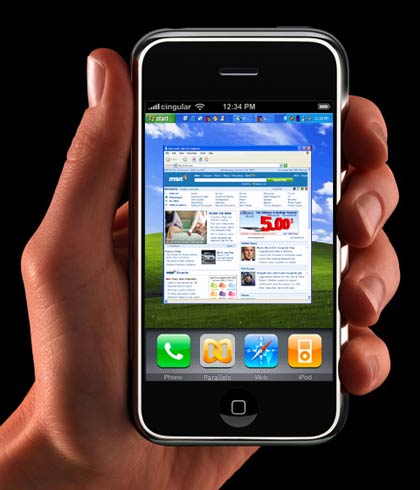Smartphone Evolution & History
"A smartphone is a mobile phone offering advanced capabilities beyond a typical mobile phone, often with PC-like functionality. There is no industry standard definition of a smartphone.[1][2] For some, a smartphone is a phone that runs complete operating system software providing a standardized interface and platform for application developers.[3][4] For others, a smartphone is simply a phone with advanced features."Well for me?I think,often with pc-like function?Izzit true?Not much smartphone can hook on an external display like projector,HDTV;Can a smartphone do autocading or programming works?;Can a smartphone delivers high definitons gaming graphics?So i dont think so.Its only a packed chick in a chunk of plastic or metal body with OS only.
So what's the first smartphone in the world?

The first smartphone was called Simon designed by IBM in 1992 and shown as a concept product that year at COMDEX, the computer industry trade show held in Las Vegas, Nevada. It was released to the public in 1993 and sold by BellSouth. Besides being a mobile phone, it also contained a calendar, address book, world clock, calculator, note pad, e-mail, send and receive fax, and games. It had no physical buttons to dial with. Instead customers used a touch-screen to select phone with a finger or create facsimiles and memos with an optional stylus. Text was entered with a unique on-screen "predictive" keyboard. By today's standards, the Simon would be a fairly low-end smartphone.
The Nokia Communicator line was the first of Nokia's smartphones starting with the Nokia 9000(Known as Pencil Box), released in 1996. This distinctive palmtop computer style smartphone was the result of a collaborative effort of an early successful and expensive PDA model by Hewlett Packard combined with Nokia's bestselling phone around that time and early prototype models had the two devices fixed via a hinge; (The color displays revolution begins)the Nokia 9210 as the first color screen Communicator model which was the first true smartphone with an open operating system; the 9500 Communicator that was also Nokia's first cameraphone Communicator and Nokia's first WiFi phone; the 9300 Communicator was the third dimensional shift into a smaller form factor; and the latest E90 Communicator includes GPS. The Nokia Communicator model is remarkable also having been the most expensive phone model sold by a major brand for almost the full lifespan of the model series, easily 20% and sometimes 40% more expensive than the next most expensive smartphone by any major manufacturer.
The Ericsson R380 was sold as a 'smartphone' but could not run native third-party applications.[8] Although the Nokia 9210 was arguably the first true smartphone with an open operating system, Nokia continued to refer to it as a Communicator.
In 2001 RIM released the first BlackBerry which was the first smartphone optimized for wireless email use and has achieved a total customer base of 8 million subscribers by June 2007, of which three fourths are in North America.
Although the Nokia 7650, announced in 2001, was referred to as a 'smart phone' in the media, and is now called a 'smartphone' on the Nokia support site, the press release referred to it as an 'imaging phone'.[9][10][11] Handspring delivered the first widely popular smartphone devices in the US market by marrying its Palm OS based Visor PDA together with a piggybacked GSM phone module. By 2002, Handspring was marketing an integrated package called the Treo; the company was subsequently bought by Palm primarily because the PDA market was dying but the Treo smartphone was quickly becoming popular as a phone with extended PDA organizer features. That same year, Microsoft announced its Windows CE Pocket PC OS would be offered as "Microsoft Windows Powered Smartphone 2002".[12] Microsoft originally defined its Windows Smartphone products as lacking a touchscreen and offering a lower screen resolution compared to its sibling Pocket PC devices. Palm has since largely abandoned its own Palm OS in favor of licensing Microsoft's WinCE-based operating system now referred to as Windows Mobile, although WinCE and Palm OS together now amount to 10% of the smartphone market.
In 2005 Nokia launched its N-Series of 3G smartphones which Nokia started to market not as mobile phones but as multimedia computers.
Out of 1 billion camera phones to be shipped in 2008, smartphones, the higher end of the market with full email support, will represent about 10% of the market or about 100 million units.[citation needed]
The Smartphone Summit semi-annual conference details smartphone industry market data, trends, and updates among smartphone related hardware, software, and accessories.

Untill now,many of modern smartphones are shipped with Windows Mobile and Symbian OS like
Motorola Q,O2 XDA,HTC Touch Cruise and others.But some of manufacturer like Palm,Treo,Apple will still using their own "Sauces" like Palm os,Mac oxs and etc.
Conclusion,so what's the sign of now?Smartphones will be replacing conventional firmware phones?Or smartphones will be replaced by EEE PC due to lower price?But till now the answer is not!Smartphones will be still leading up now.My dream smartphones is Iphone,althought im not an apple fans,but i have to admit that the awesomeness of iphone which delivering perfection in terms of beauty and the versatility.As i heard iphone will able to run VMware and able to support parallel OSes like symbian?Huh?Who knows?=D And Iphone now officialy shiping with 3G support.While the cons is some of user complaint for the disappointing battery life,izzit true?We dont know.Haha..
SkyChin-The Author.

I live dream to inspire people,an outccast to normality.



0 comments: